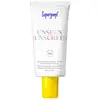What's inside
What's inside
 Key Ingredients
Key Ingredients

 Benefits
Benefits

 Concerns
Concerns

 Ingredients Side-by-side
Ingredients Side-by-side

Water
Skin ConditioningButyloctyl Salicylate
Skin ConditioningCaprylic/Capric Triglyceride
MaskingCaprylyl Glycol
EmollientCarthamus Tinctorius Oleosomes
EmollientCellulose Gum
Emulsion StabilisingCetearyl Alcohol
EmollientCitric Acid
BufferingCoco-Glucoside
CleansingCocos Nucifera Oil
MaskingDicaprylyl Carbonate
EmollientDiisooctyl Succinate
EmollientDimethicone
EmollientEthylene/Propylene/Styrene Copolymer
Ethylhexyl Methoxycrylene
Skin ConditioningEthylhexylglycerin
Skin ConditioningEuterpe Oleracea Fruit Oil
Skin ConditioningGluconolactone
Skin ConditioningGlycerin
HumectantHectorite
AbsorbentHydroxyethyl Acrylate/Sodium Acryloyldimethyl Taurate Copolymer
Emulsion StabilisingHydroxyethylcellulose
Emulsion StabilisingCI 77491
Cosmetic ColorantCI 77499
Cosmetic ColorantIsononyl Isononanoate
EmollientMaleated Soybean Oil Glyceryl/Octyldodecanol Esters
Mica
Cosmetic ColorantMicrocrystalline Cellulose
AbsorbentNiacinamide
SmoothingParfum
MaskingPhenoxyethanol
PreservativePolyhydroxystearic Acid
EmulsifyingPolysorbate 20
EmulsifyingPolysorbate 60
EmulsifyingPongamia Pinnata Seed Extract
Skin ConditioningSodium Benzoate
MaskingSodium Stearoyl Glutamate
CleansingSorbitan Isostearate
EmulsifyingSorbitan Oleate
EmulsifyingTetrasodium Glutamate Diacetate
Theobroma Grandiflorum Seed Butter
Skin ConditioningCI 77891
Cosmetic ColorantTocopherol
AntioxidantTriethoxycaprylylsilane
Benzyl Salicylate
PerfumingCitronellol
PerfumingLimonene
PerfumingWater, Butyloctyl Salicylate, Caprylic/Capric Triglyceride, Caprylyl Glycol, Carthamus Tinctorius Oleosomes, Cellulose Gum, Cetearyl Alcohol, Citric Acid, Coco-Glucoside, Cocos Nucifera Oil, Dicaprylyl Carbonate, Diisooctyl Succinate, Dimethicone, Ethylene/Propylene/Styrene Copolymer, Ethylhexyl Methoxycrylene, Ethylhexylglycerin, Euterpe Oleracea Fruit Oil, Gluconolactone, Glycerin, Hectorite, Hydroxyethyl Acrylate/Sodium Acryloyldimethyl Taurate Copolymer, Hydroxyethylcellulose, CI 77491, CI 77499, Isononyl Isononanoate, Maleated Soybean Oil Glyceryl/Octyldodecanol Esters, Mica, Microcrystalline Cellulose, Niacinamide, Parfum, Phenoxyethanol, Polyhydroxystearic Acid, Polysorbate 20, Polysorbate 60, Pongamia Pinnata Seed Extract, Sodium Benzoate, Sodium Stearoyl Glutamate, Sorbitan Isostearate, Sorbitan Oleate, Tetrasodium Glutamate Diacetate, Theobroma Grandiflorum Seed Butter, CI 77891, Tocopherol, Triethoxycaprylylsilane, Benzyl Salicylate, Citronellol, Limonene
Butyl Methoxydibenzoylmethane 3%
UV AbsorberHomosalate 8%
Skin ConditioningEthylhexyl Salicylate 5%
UV AbsorberOctocrylene 4%
UV AbsorberIsododecane
EmollientDimethicone Crosspolymer
Emulsion StabilisingDimethicone/Bis-Isobutyl PPG-20 Crosspolymer
EmollientPolymethylsilsesquioxane
Isohexadecane
EmollientDicaprylyl Carbonate
EmollientMeadowfoam Estolide
Skin ConditioningCaprylic/Capric Triglyceride
MaskingPolyester-7
Skin ConditioningNeopentyl Glycol Diheptanoate
EmollientLithothamnion Calcareum Extract
Skin ConditioningCaprylyl Glycol
EmollientButyrospermum Parkii Butter
Skin ConditioningJojoba Esters
EmollientMannitol
HumectantBoswellia Serrata Resin Extract
SmoothingLecithin
EmollientMicrocrystalline Cellulose
AbsorbentDiatomaceous Earth
AbrasiveZinc Sulfate
AntimicrobialSilica
AbrasiveTocopherol
AntioxidantButyl Methoxydibenzoylmethane 3%, Homosalate 8%, Ethylhexyl Salicylate 5%, Octocrylene 4%, Isododecane, Dimethicone Crosspolymer, Dimethicone/Bis-Isobutyl PPG-20 Crosspolymer, Polymethylsilsesquioxane, Isohexadecane, Dicaprylyl Carbonate, Meadowfoam Estolide, Caprylic/Capric Triglyceride, Polyester-7, Neopentyl Glycol Diheptanoate, Lithothamnion Calcareum Extract, Caprylyl Glycol, Butyrospermum Parkii Butter, Jojoba Esters, Mannitol, Boswellia Serrata Resin Extract, Lecithin, Microcrystalline Cellulose, Diatomaceous Earth, Zinc Sulfate, Silica, Tocopherol
 Reviews
Reviews

Ingredients Explained
These ingredients are found in both products.
Ingredients higher up in an ingredient list are typically present in a larger amount.
This ingredient is an emollient, solvent, and texture enhancer. It is considered a skin-softener by helping the skin prevent moisture loss.
It helps thicken a product's formula and makes it easier to spread by dissolving clumping compounds.
Caprylic Triglyceride is made by combining glycerin with coconut oil, forming a clear liquid.
While there is an assumption Caprylic Triglyceride can clog pores due to it being derived from coconut oil, there is no research supporting this.
Learn more about Caprylic/Capric TriglycerideCaprylyl Glycol is a humectant and emollient, meaning it attracts and preserves moisture.
It is a common ingredient in many products, especially those designed to hydrate skin. The primary benefits are retaining moisture, skin softening, and promoting a healthy skin barrier.
Though Caprylyl Glycol is an alcohol derived from fatty acids, it is not the kind that can dry out skin.
This ingredient is also used as a preservative to extend the life of products. It has slight antimicrobial properties.
Learn more about Caprylyl GlycolDicaprylyl Carbonate comes from carbonic acid and caprylyl alcohol, a fatty alcohol. It is an emollient and gives skin a velvet feel. The sources of Dicaprylyl Carbonate may be synthetic or from animals.
As an emollient, Dicaprylyl Carbonate creates a film on the skin. This film traps moisture in, keeping your skin soft and hydrated.
Microcrystalline Cellulose is another name for refined wood pulp. It is used as an emulsifier and mattifying ingredient. As an emulsifier, it helps keep ingredients together.
Tocopherol (also known as Vitamin E) is a common antioxidant used to help protect the skin from free-radicals and strengthen the skin barrier. It's also fat soluble - this means our skin is great at absorbing it.
Vitamin E also helps keep your natural skin lipids healthy. Your lipid skin barrier naturally consists of lipids, ceramides, and fatty acids. Vitamin E offers extra protection for your skin’s lipid barrier, keeping your skin healthy and nourished.
Another benefit is a bit of UV protection. Vitamin E helps reduce the damage caused by UVB rays. (It should not replace your sunscreen). Combining it with Vitamin C can decrease sunburned cells and hyperpigmentation after UV exposure.
You might have noticed Vitamin E + C often paired together. This is because it is great at stabilizing Vitamin C. Using the two together helps increase the effectiveness of both ingredients.
There are often claims that Vitamin E can reduce/prevent scarring, but these claims haven't been confirmed by scientific research.
Learn more about Tocopherol